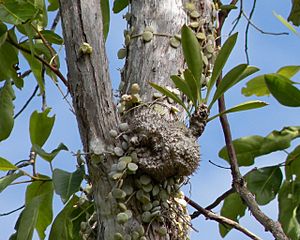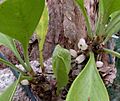Myrmecodia beccarii facts for kids
Quick facts for kids Myrmecodia beccarii |
|
|---|---|
 |
|
| Myrmecodia beccarii with Dischidia nummularia | |
| Scientific classification | |
| Kingdom: | |
| (unranked): | |
| (unranked): | |
| (unranked): | |
| Order: | |
| Family: | |
| Genus: |
Myrmecodia
|
| Species: |
beccarii
|
| Binomial name | |
| Myrmecodia beccarii Hook f.
|
|
Myrmecodia beccarii, also known as the ant-house plant, is a fascinating plant that grows on trees. It's called an "ant-house plant" because it provides a special home for ants! You can find this unique plant in the tropical wetlands and mangrove areas of northern Queensland, Australia.
Contents
Meet the Ant-House Plant!
Where Does It Live?
The ant-house plant is an epiphyte. This means it grows on other plants, like Melaleuca trees, but it doesn't harm them. It just uses them for support. It prefers trees with soft, spongy bark. These plants are found in the wet, warm areas of tropical north Queensland, Australia. This area stretches from Cooktown down to Mission Beach.
A Special Home for Ants
The ant-house plant has a very unique stem. It's prickly and swollen, and it naturally forms hollow spaces inside. These hollows become home to a type of ant called the golden ant (Iridomyrmex cordatus).
This is a special partnership, called a symbiosis. The ants live inside the plant, and in return, they help protect it. The ants patrol the plant, chasing away any insects that try to eat its leaves. In return, the plant absorbs nutrients from the ants' waste. It's a win-win for both the plant and the ants!
Flowers, Fruit, and Reproduction
The ant-house plant produces small, white, tube-shaped flowers. These flowers are about 10 millimeters (less than half an inch) long. After the flowers, the plant grows small, white or clear fruits. Each fruit holds just one seed.
These seeds are spread to other trees by a bird called the mistletoebird (Dicaeum hirundinaceum). The bird eats the fruit and then drops the seeds onto other trees, helping the plant to grow in new places.
Butterflies and Ants: A Tricky Friendship
The ant-house plant also has a special connection with a butterfly called the Apollo jewel butterfly (Hypochrysops apollo apollo). This butterfly lays its eggs on the ant-house plant.
Here's the clever part: the butterfly eggs smell like ant eggs! Because of this, the golden ants pick up the butterfly eggs and carry them inside their home within the plant. The butterfly larvae (caterpillars) then grow inside the plant, protected by the ants. When they are ready, the adult butterflies emerge and fly away. This type of relationship, where butterflies and ants interact closely, is common in the Lycaenidae family of butterflies, which are often called "blues."
Images for kids



